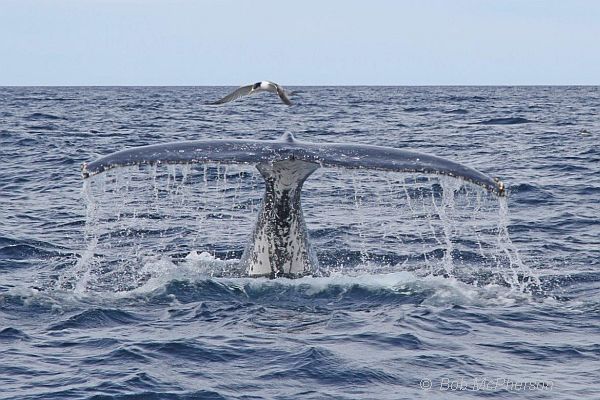Humpback Whale (Southern)
Southern Humpback WhaleMegaptera novaeangliae australis | |
|---|---|
| Kingdom: | Animalia |
| Phylum: | Chordata |
| Class: | Mammalia |
| Order: | Cetacea |
| Family: | Balaenidae |
| Status | |
| World: | Endangered (Oceania sub-population (IUCN Red List 2008) |
| Australia: | Migratory sp. Listed (EPBC Act 1999) |
| Victoria: | Critically endangered (FFG Threatened List 2023) |
| FFG: | (Action Statement No.247) |
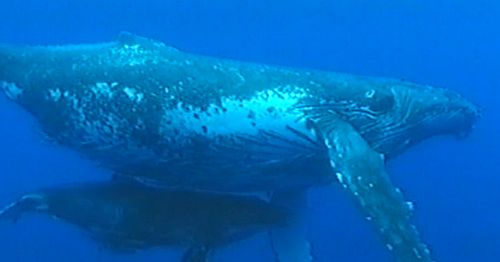
The Southern Humpback Whale (Megaptera novaeangliae australis) is one of six species in the family Balaenopteridae, also known as baleen whales or rorquals. This group of whales all have a pleated throat and ventral groves that expand to allow large volumes of water and plankton to be taken and filtered through ‘baleen’ when feeding.
Humpbacks are black or dark brown above and mainly white underneath including the throat grooves. The Humpback Whale is readily distinguishable from all other whales by its flippers which are almost one third of the body length; they are described in the genus Megaptera, from the Greek megas – great and pteron – wing. Other distinctive features include, tubercules (enlarged sensory hair follicles) on upper and lower jaw, and protuberances on the pectoral flippers. Average length, male 13m, and female 13.9m weighing up to 45 tonnes.
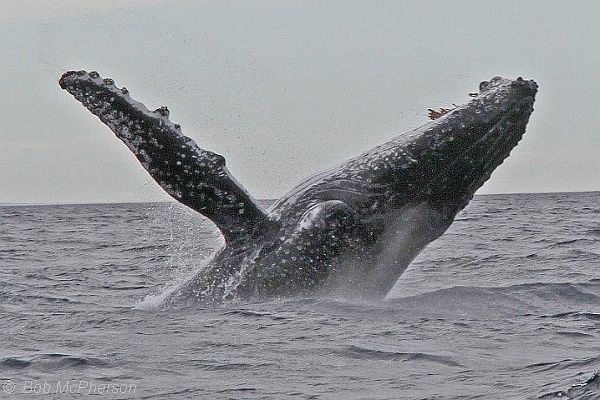
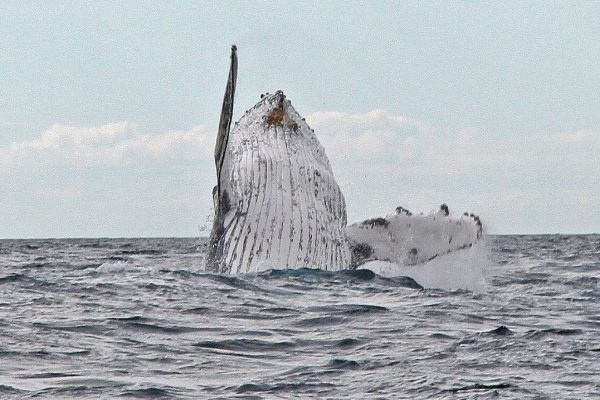
Four genetically different breeding populations are recognised in the South Pacific and Australia referred to as the Oceania or Southern sub-species:
- Western Australia
- Eastern Australia, New Caledonia and Tonga (further sub-divided into distinct breeding populations)
- Cook Islands and French Polynesia
- West coast of South America
(IUCN 2008)
Distribution in Victoria
Humpback Whales have a worldwide distribution with discrete populations in the Northern and Southern Hemisphere separated by the equatorial region. The Southern Hemisphere population comprises seven discrete sub-populations or stocks. There are two populations that migrate from Antarctica to Australia, one population migrates along the east coast of Australia and the other migrates along the coast of Western Australia. Some Humpback Whales enter Victorian waters on their migratory path and occasionally enter Port Phillip Bay and Western Port Bay.
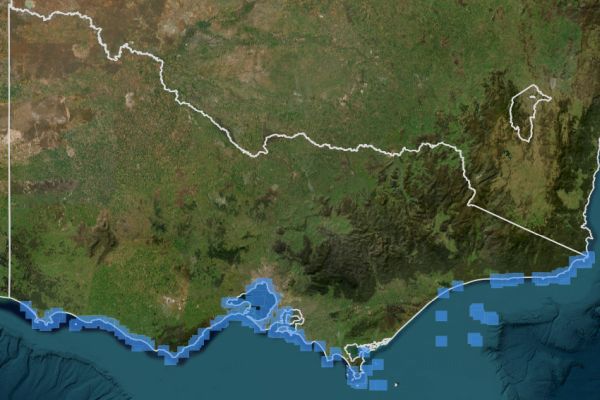
All known records of Humpback Whale in Victoria. Source: VVB 2024.
The highest number of humpback whales passing through Victorian waters is on their northern migration which occurs in June-July.
Some whales pass through Victorian waters on their southern migration in September to October.
Population decline
Humpback Whale stocks in the Southern Hemisphere have been subject to commercial whaling since the mid 1800s. Commencement of pelagic fishing in Antarctic waters in 1912 significantly expanded harvest potential and more than 200,000 were taken in the 20th century, including thousands of illegal catches taken up to 1973, this being well after the 1963 International Whaling Commission ban on the taking Humpbacks which now provides protection.1
The collective Oceania population is estimated to be around 4,300 (1995 to 2005 estimates) (IWC 2024). Surveys conducted in 2015 estimate the Eastern Australia population to be 24,545 with a 10.9% increase per annum (Noad et al. 2019).
Habitat & ecology
Feeding
Humpback Whale habitat varies according to seasonal influences on feeding, migrating and breeding behaviour. The main feeding habitat is in Antarctic waters (south of the Antarctic convergence 550-600S) where Krill (Euphausia superba) form extensive surface swarms during the summer months.
Feeding on schools of bait fish has been observed off the southern NSW coast at Bermagui in September 2021, where large numbers of humpbacks used a bubble feeding technique to encircle the baitfish. This type of feeding behaviour has not been documented in Australian waters until recently recorded by Sapphire Coastal Adventures.
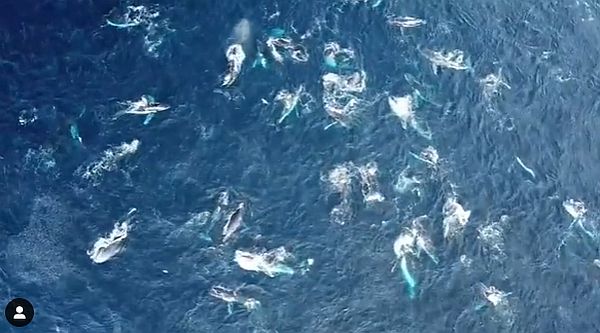
Breeding
Mating and calving during winter is carried out in tropical and sub-tropical waters protected by offshore reefs and islands, eg. Great Barrier Reef waters north of Hervey Bay whilst resting areas often include large embayments. Humpback Whales live at least 48 years; natural predators include sharks and Killer Whales mainly preying on calves.
The mating and calving season ranges from June to October. Females give birth to one calf every 2-3 years with gestation 11 to 11.5 months. Calves are 4 to 4.6 metres at birth and weaned at up to 11 months of age, length at independence is 8 to 10 metres.2 Interbreeding (gene flow) between populations is low and limited to only a few females per generation.3
Movement
Migratory habitat includes both open ocean and continental waters where Humpbacks often travel in close proximity to the coastline.
Migration north from Antarctica occurs from late April to early May.
Females with weaning yearlings are first to leave Antarctic waters whilst females in late pregnancy are last to leave with the highest number passing through Victorian waters in June-July.
Migration south from calving areas occurs from mid August through to mid October. Females in early pregnancy head south first, followed by immature whales then mature males/resting females and last lactating females with suckling calves.4
Some whales on the southern migration pass through Victorian waters in Sept-Oct. Humpback Whales are mainly solitary or mother and calf associations, although during migration they often swim together or in small groups which may be segregated into age, sex and reproductive class. Kin selection is not found amongst migrating groups apart from mother and calves.5 Male humpbacks sing complex songs that are thought to be associated with communication within a population and mating selection. Songs vary between populations, and change progressively within and between seasons with the integrity of songs being maintained over long distances (1500 km) on migratory paths.6
.
Threats
Threats to Humpback Whales in Bass Strait include entanglement in commercial fishing gear, marine noise, intense levels of whale watching, Oil Spills, ingestion of marine debris and collision with large vessels. Potential threats to the wider population include resumption of commercial whaling and expansion of the krill fishery in Antarctic waters. Climate change could impact on the availability of food (krill) in the Antarctic region through a reduced area of sea ice, changes in sea temperature and reduced upwelling of nutrient rich currents.
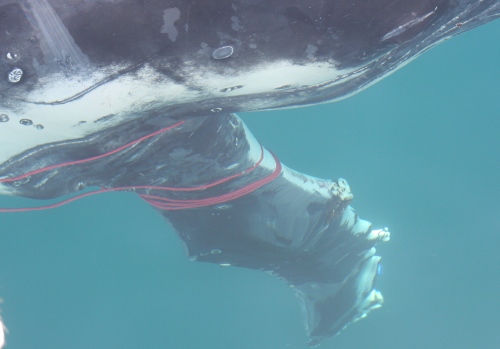
A female Humpback Whale became entangled in crayfish pot float line on 1 July 2005 off Port Fairy. With assistance from a commercial fisher officers from DELWP and Fisheries assisted in freeing the whale.
Story of Humback Whale towing 800kg of abandoned fishing gear and freed off Gippsland coast June 2024.ABC news.
References
- 1Paterson, R.A. (2001) Exploitation of humpback whales, Megaptera novaeangliae, in the South West Pacific and adjacent Antarctic waters during the 19th and 20th Centuries, Memoirs of the Queensland Museum 47(2): 421-429. Brisbane.
- 2Clapham, P.J., Wetmore, S.E., Smith, T.D., Mead, J.G., (1999) Length at birth and at independence in humpback whales, J. Cetacean Res. Manag., Vol. 1 No.2 pp141-146, 1999.
- 3Baker, C.S., Florez-Gonzalez, L., Abernethy, B., Rosenbaum, C.H., Slade, R.W., Capella, J., Bannister, J.L., (1998), Mitochondrial DNA variation and maternal gene flow among humpback whales of the Southern Hemisphere, Marine Mammal Science, 14(4): 721-737 (October 1998)
- 4Dawbin, W.H., (1966) The Seasonal Migratory Cycle of Humpback Whales, In Whales, Dolphins and Porpoises, Ed. Norris, K., University of California Press, Berkeley and Los Angeles 1966.
- 5Valsecchi, E., Hale, P., Corkeron, P., Amoss, W., (2002), Social structure in migrating humpback whales (Megaptera novaeangliae), Molecular Ecology (2002) 11, 507-518, Blackwell Science Ltd.
- 6Cato, D.H. (1991) Songs of humpback whales: the Australian perspective, Memoirs of the Queensland Museum Vol 47(2):277-290.
- FFG Threatened List 2023, Department of Energy,Environment and Climate Change (DEECA), June 2023..
- IWC (2024) International Whaling Commission, Humpack population estimates https://iwc.int/about-whales/estimate Accessed January 2024.
-
Noad, Michael J., Kniest, Eric, and Dunlop, Rebecca A. (2019). Boom to bust? Implications for the continued rapid growth of the eastern Australian humpback whale population despite recovery. Population Ecology 61 (2) 198-209. https://doi.org/10.1002/1438-390x.1014
-
VVB (2024) Visualising Victoria's Biodiversity
Whale watching
| Minimum distances for approaching whales, dolphins and seals in Victoria | ||||
| Swimmer or Surfer | Recreational Vessel | Jet Ski | Aircraft | |
| Dolphin | 30 m | 100 m | 300 m | #500 m |
| Whale | 50 m | 200 m | 300 m | #500 m |
| Seal on land 30 m | ||||
Special protections zones exist at several sites along the Victorian coastline which have more stringent minimum distances regulated under the WILDLIFE (MARINE MAMMALS) REGULATIONS 2009
Sightings summaries
2011 summary
- 30 July - Logans Beach 1 x Humpback Whale heading east.
- On 4 August two Humpback Whales were sighted at Barwon Heads and another two at Port Phillip Heads. On 13 August 1 pod of Humpback Whales were seen in Port Phillip Bay. On 17 August 2-3 Humpback Whales were seen at Portland.
2012 summary
A confirmed Humpback sighting was recorded at Cape Nelson on 4 July. There have been unconfirmed sightings of Humpback Whales reported off Bridgewater Bay, Cape Otway and Lorne during June-July.
2013 Summary
The first confirmed Humpback Whale sighting was on 28 May at Westernport Bay with 2 Humpbacks observed. On the 1 June 2013 a Humpback was observed at Port Fairy. On 9 June 3-5 Humpbacks were observed at Portland. Humpbacks were also recorded at Portsea, Cape Liptrap, Walkerville, Barwon Heads, Cape Conran and in Port Phillip Bay. A cow and calf pair was observed off Cape Liptrap on 18 June 2013.
2014 Summary
The first validated Humpback Whale sighting was in Portland Bay on 27 May. During May and June sightings of one or two Humpbacks were recorded off Port Fairy lighthouse, Portland Bay and Port Phillip Bay. On 18 June four Humpbacks were sighted off Logans Beach, Warnambool.
2015 Summary
The first Humpback Whale sighting was on 27 May at Portland the last Humpback Whale was on 7 August (could have been late migration north). Detailed sightings collected by Mandy Watson, DELWP, Warrnambool.
- 27 May Portland 1 x Humpback Whale (HBW)
- 7 June Port Fairy 2 x HBW
- 9 June Portland 2 x HBW
- 13 June Logans Beach 3 x HBW
- 18 June Logans Beach 4 - 5 HBW
- 2 Jul Geelong 1 x HBW
- 3 Jul Portsea back beach 2 x HBW
- 6 Jul Portsea back beach 1 + HBW
- 7 Jul Peterborough 3 x HBW
- 8 Jul Princetown 6 + HBW
- 20 Jul Sorrento back beach 2 x HBW
- 21 Jul Sorrento back beach 1 x HBW
- 24 Jul Port Fairy 2 x HBW
- 7 Aug Warrnambool 1 x HBW
2016 Summary
- 15 Jun Cape Patton 2 x HBW
- 12 Aug 2 x HBW Logans Beach
2017 Summary
- 28 May Rye back beach 1 x HBW
- 11 June Logans Beach 6 x HBW
- 11 June Portland 5 x HBW
- 11 June Lorne 2 x HBW
- 12 June Logans Beach 12 x HBW
- 13 June Logans Beach 2 x HBW
- 14 June Logans Beach 2 x HBW
- 15 June Point Hicks, East Gippsland 13 x HBW
- 16 June Port Phillip Bay 2 x HBW
- 16 June Bridgewater, The Blowholes 6 x HBW
- 17 June London Bridge, Portsea 1 x HBW
- 20 June Logans Beach 2 x HBW
- 22 June Point Nepean 3 x HBW
- 29 June Logans Beach 3 x HBW
- 2 July Cape Nelson 4 x HBW
- 6 July Logans Beach 15 x HBW
- 6 July Warrnambool 2 x HBW
2018 Summary
- 1 June Logans Beach 4 x HBW
- 2 June Port Fairy 2 x HBW
- 3 June Logans Beach 3 x HBW
- 6 June Portland 1 x HBW
- 6 June Port Phillip Bay 2 x HBW
- 8 June Logans Beach 1 x HBW
- 9 June Logans Beach 2 x HBW
- 11 June Warrnambool 8 x HBW
- 20 June Cape Nelson 2 x HBW
- 21 June Logans Beach 3 x HBW
- 22 June Portland 2 x HBW
- 22 June Cape Nelson 1 x HBW
- 23 June Portland 2 x Humpback Whale
- 24 June Warrnambool 1 x Humpback Whale
- 28 June Portland 2 x HBW
- 10 July Portland 1 x HBW
- 12 July Portland 1 x HBW
- 12 July Portland 5 x HBW
- 13 July Cape Bridgewater x 2 HBW
- 21 July Phillip Island 1 x HBW
- 23 July Logan’s Beach 2 x HBW
- 23 July Portland 1 x HBW
- 27 July Phillip Island 1 x HBW
- 28 July Cape Nelson 4 x HBW
- 28 July Phillip Island 1 x HBW
- 2 August Nelson Bay 1 x HBW
2019 Summary
- 22 May Cape Schanck 1 x HBW
- 1 June Logans Beach 3 x HBW
- 8 June Cape Schanck 1 x HBW
- 23 June Portland 8 x HBW
- 23 June Cape Liptrap 1 x HBW
- 28 June Barwon Heads 2 x HBW
- 19 July Cape Schanck 1 x HBW
- 20 July Logans Beach 2 x HBW
- 21 July Point Lonsdale 2 x HBW
- 23 July Cape Nelson 8 x HBW
- 25 July Logans Beach 2 x HBW
- 1 August Logans Beach 3 x HBW
- 5 August Warrnambool 1 x HBW
- 7 August Portland 2 x HBW
- 8 August Cape Nelson 1 x HBW
- 7 September Cape Nelson 1 x HBW
- 8 September Cape Nelson 1 x HBW
- 12 September Cape Nelson 1 x HBW
- 14 September Cape Nelson multiple HBW
- 15 September Portland 1 x HBW
2020 Summary
There have been numerous sightings of Humpback Whales in Victoria this season, therefore we have not included every sighting.
During late September to early October, Humpback Whales have been observed feeding off Portland. This is becoming a regular phenomenon off Portland at the end of the whale season.
More information
- Humpback Whale Recovery Plan 2005-2010
- Action Plan for Australian Cetaceans
- Department of the Environment -Species profile & threats database
- National Guidelines for Cetacean Observation & Areas of Special Interest for Cetacean Observation
- Sonar and seismic impacts
- International Fund for Animal Welfare defending whales
- ICUN Red List (2008) Childerhouse, S., Jackson, J., Baker, C.S., Gales, N., Clapham, P.J. & Brownell Jr., R.L. 2008. Megaptera novaeangliae (Oceania subpopulation). The IUCN Red List of Threatened Species 2008:
e.T132832A3463914. http://dx.doi.org/10.2305/IUCN.UK.2008.RLTS.T132832A3463914.en - IUCN Red List Megaptera novaeangliae Oceania subpopulation (Humpback Whale) (iucnredlist.org)
- International Whaling Commission
- Commission for the Conservation of Antarctic Marine Living Resources
- Convention on International Trade in Endangered Species of Wild Flora & Fauna
- Convention of Migratory Species
- Humpback Whale (Megaptera novaeangliae) IUCN Oceania subpopulation – American Samoa Stock Noaa 2009 https://media.fisheries.noaa.gov/dam-migration/po2009whhb-as_508.pdf
- Southern Right Whale SE Australia monitoring program
- Southern Right Whale
- Whale sightings along the Great Ocean Road
If you see an entangled whale or any whale that appears to have rope markings on it's body please call the Whale and Dolphin Emergency Hotline on 1300 136 017
